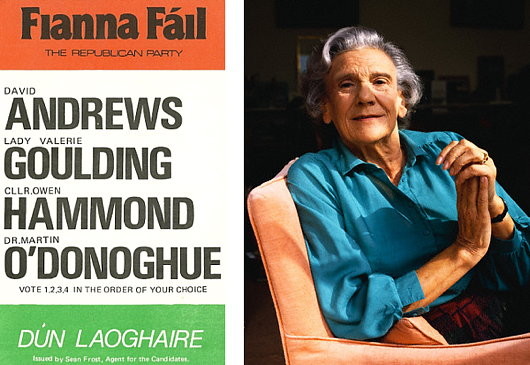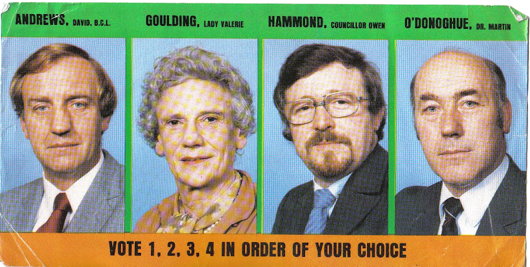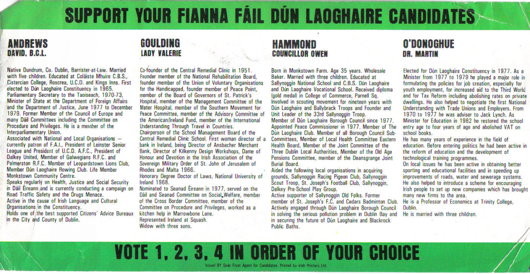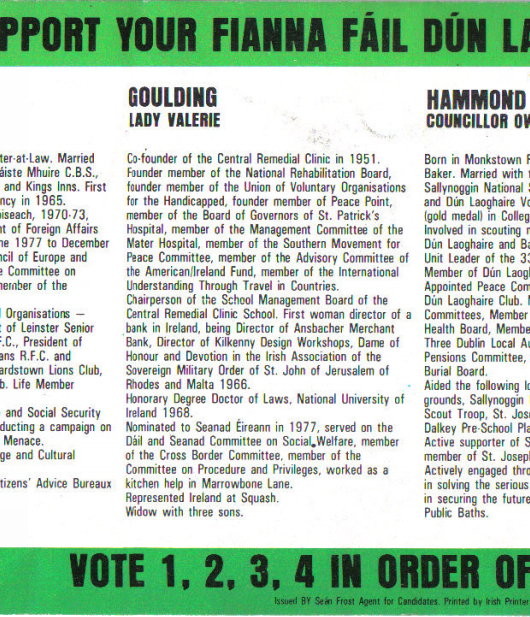
About Andrew Cusack
 Writer, web designer, etc.; born in New York; educated in Argentina, Scotland, and South Africa; now based in London.
Writer, web designer, etc.; born in New York; educated in Argentina, Scotland, and South Africa; now based in London. read more
News
Blogs
Reviews & Periodicals
Arts & Design
World
France
Mitteleuropa
Knickerbockers
Argentina
The Levant
Africa
Cape of Good Hope
Netherlands
Scandinavia
Québec
India
Muscovy
Germany
Academica

The Hon. Lady Goulding
Grande dame of charity and sometime Fianna Fáil senator who provided a ‘harbour of hope’ for the disabled & represented Ireland in squash
IF, LIKE ME, YOUR Venn diagram shows a massive overlap for the circles representing politics, history, aesthetics, and design, then the Irish Election Literature website is a dangerous place where you can waste many minutes of your day. Not long ago, I stumbled across their collection of electoral bits related to Valerie, the Hon. Lady Goulding — at least I think that’s the proper style, these realms are arcane and murky. She was most often, but incorrectly referred to as Lady Valerie Goulding, the fate of many wives of baronets I’m afraid.
She was born Valerie Hamilton Monckton in 1918 at Ightham Mote (pronounced “item moat”, obv.), the house noted for its Grade I listed dog kennel. Her father, Sir Walter Monckton (later 1st Viscount Monckton of Brenchley) was a trusted friend of Edward VIII, and the teenage Valerie was employed as a messenger shuttling letters between the King’s refuge at Fort Belvedere and Stanley Baldwin in Downing Street. Visiting Fort Belvedere in 1993, Lady Goulding recalled the last lunch she had attended there in December 1936:
She [Mrs Simpson] was leaving that afternoon for Cannes, and everyone was talking about nothing so as to avoid what was on everyone’s mind. But one really nice thing happened: there were four bottles of beer next to my place. The King had remembered that when we were rounding up the ponies on Dartmoor the previous year I had a beer in the pub, and that he had remarked that I was very young to be drinking. It was very touching.
In 1939 she attended the Fairyhouse races and met Sir Basil Goulding at a dinner party. Goulding had significant business interests in Ireland and became known for once entering a bank board meeting on rollerskates. On her second visit to Ireland, they became engaged, and married quickly as the threat of war loomed on the horizon. Sir Basil served in the RAF, rising to the rank of Wing Commander, while Lady Goulding opted for the First Aid Nursing Yeomanry before switching to the Auxiliary Territorial Service. After the war, the Gouldings moved to Dargle Cottage in Enniskerry, Co. Wicklow.

In 1951 she engaged upon her life’s work by founding (with Kathleen O’Rourke) the Central Remedial Clinic to provide residential care for the disabled. The Clinic started with just a few rooms but eventually grew to become the largest charitable clinic of its kind in all of Ireland. The Whitbread-winning writer Christopher Nolan attributed his literary success “to Lady Goulding and her harbour of hope” provided at the CRC.
A convert to Catholicism, from 1966 she was a Dame of Honour & Devotion in the Order of Malta. Among her many honours were the Lord Mayor of Dublin’s Award, the Gold Medal of the Royal College of Physicians of Ireland, and an honorary doctorate from the National University of Ireland.

Lady Goulding was appointed to Seanad Éireann as the nominee of taoiseach Jack Lynch, but failed in her two attempts to win a seat in the Dáil (from which this election literature originates). If ever there was an argument for the retention of the senate, it would be that Ireland is well served by the presence in the legislature of women like Lady Goulding. (Incidentally, her Fianna Fáil running mate in Dún Laoghaire was David Andrews who served as a TD from 1965 until 2002, when he was succeeded by his son Barry Andrews.)
In 1983, there was speculation that Patrick Hillery might not run for a second term as President of Ireland, and Lady Goulding was widely spoken of as a potential head of state, as were International Olympic Committee president Lord Killanin and Nobel Peace Prize laureate Sean MacBride.
Lady Goulding volunteered for innumerable charities and served on the boards of many organisations. Her Telegraph obituary notes:
She was a prominent member of the Boxer Society of Ireland, and in recent years cut a startling figure as she walked her dogs, Pericles and Minerva, through country lanes, sometimes raising what appeared to be a revolver and firing it into the air.
She would explain carefully to other, terrified, dog owners that the gun was merely a starting pistol, and was the most effective way to control her pets.
When she died in 2003, her funeral in Enniskerry was attended by the Cathaoirleach of the Seanad, and the President was represented by her aide-de-camp. The then-taoiseach Bertie Ahern noted “Her life of tireless assistance to those who most needed it, her powers of persuasion on those with whom she came in contact and her grace and charm, added further lustre to an already distinguished family tradition of public service.” Sir Anthony O’Reilly and Cardinal Connell were among those who attended the removal.
Lady Goulding is buried next to her husband in St. Patrick’s Churchyard in Enniskerry.

Search
Instagram: @andcusack
Click here for my Instagram photos.Most Recent Posts
- Sag Harbor Cinema March 26, 2025
- Teutonic Takeover March 10, 2025
- Katalin Bánffy-Jelen, R.I.P. March 3, 2025
- Substack Cusackiensis March 3, 2025
- In the Courts of the Lord February 13, 2025
Most Recent Comments
Book Wishlist
Monthly Archives
Categories


